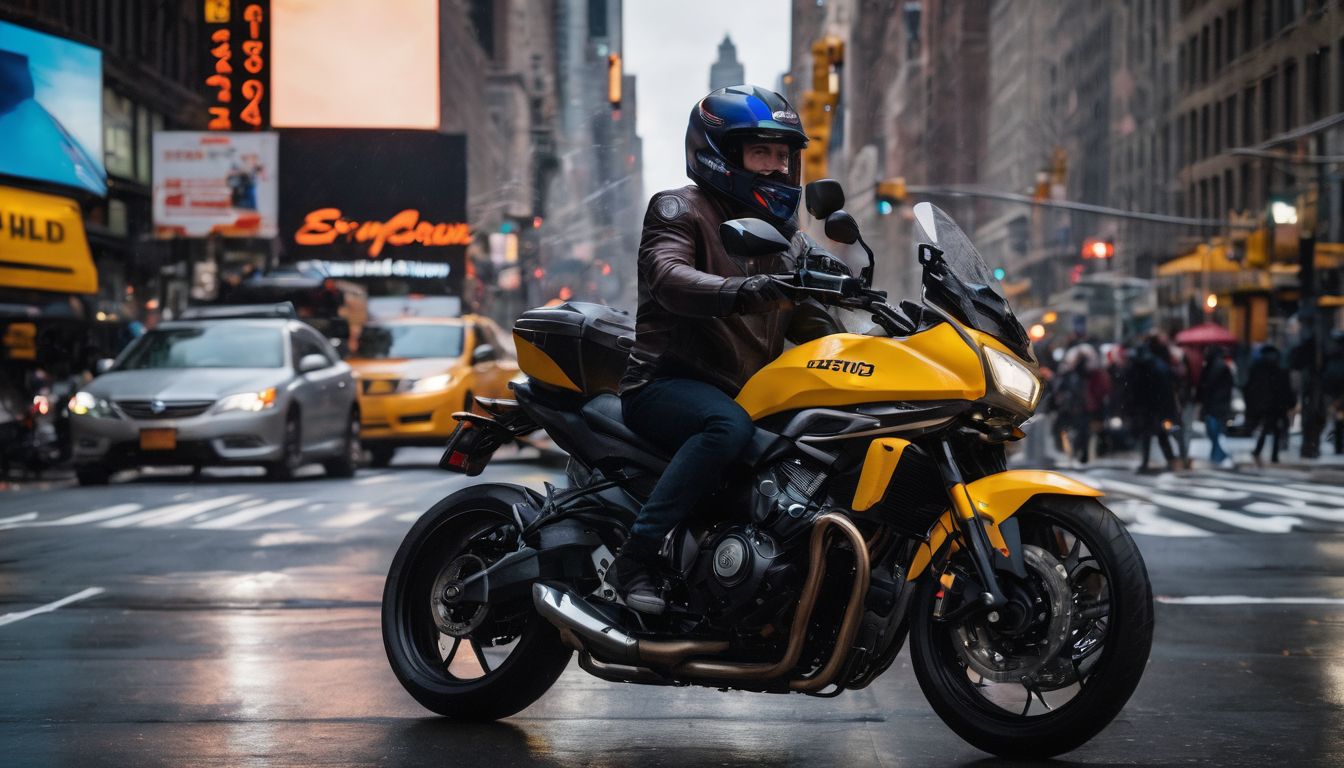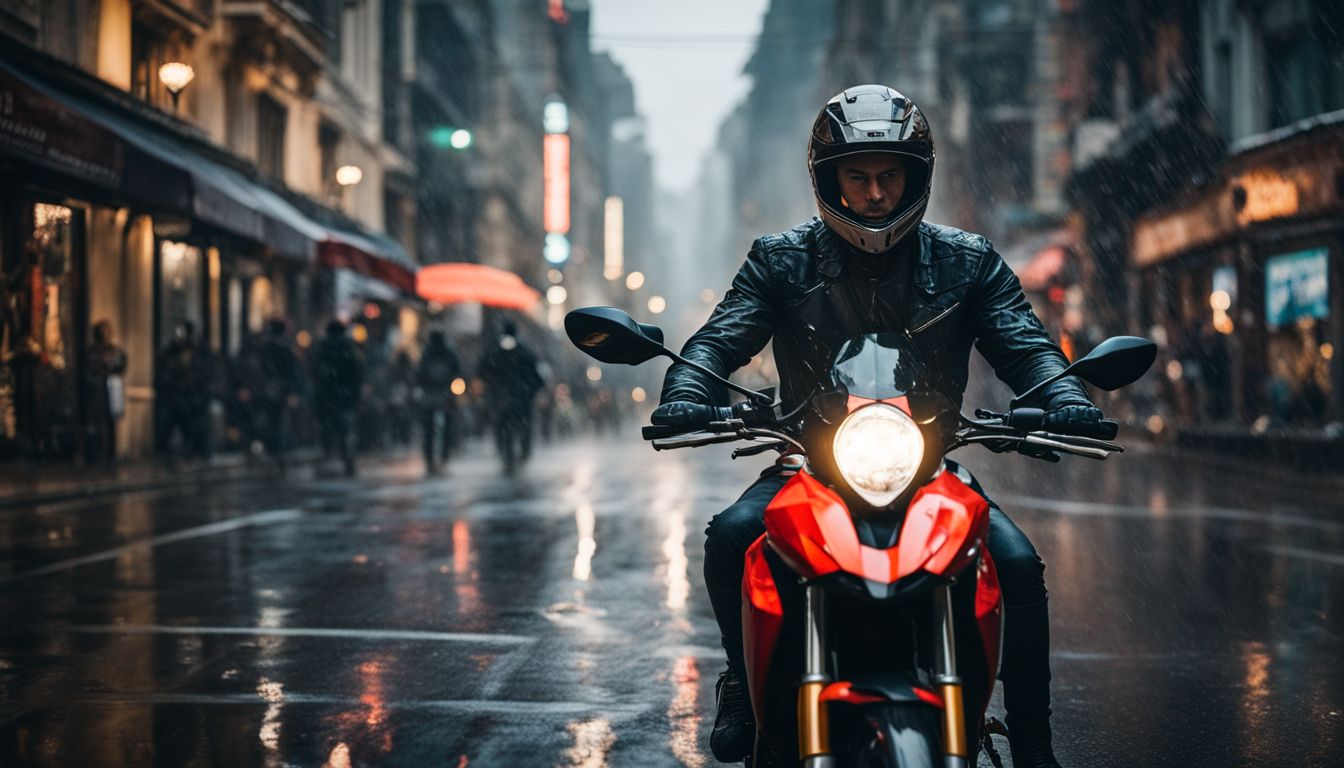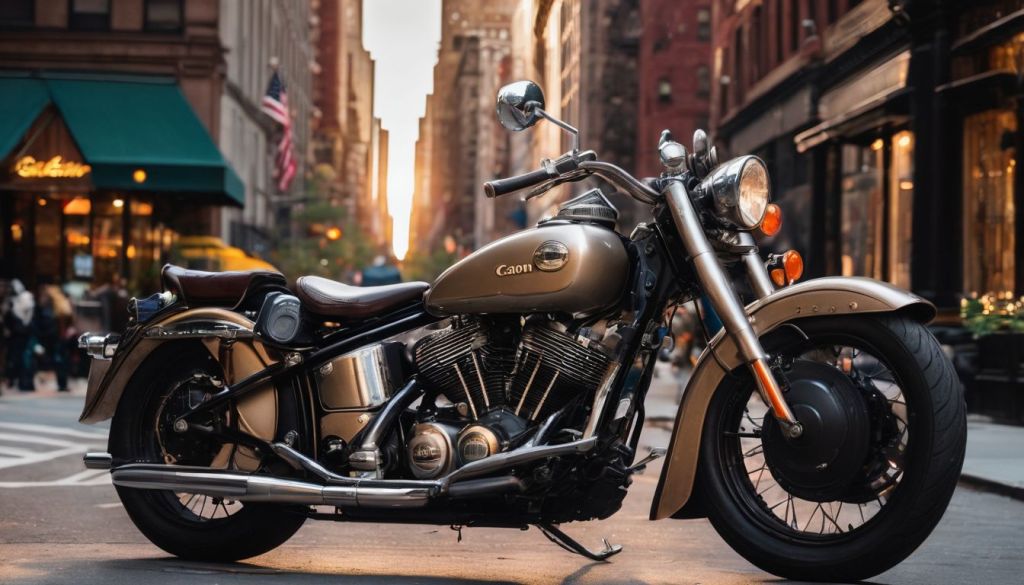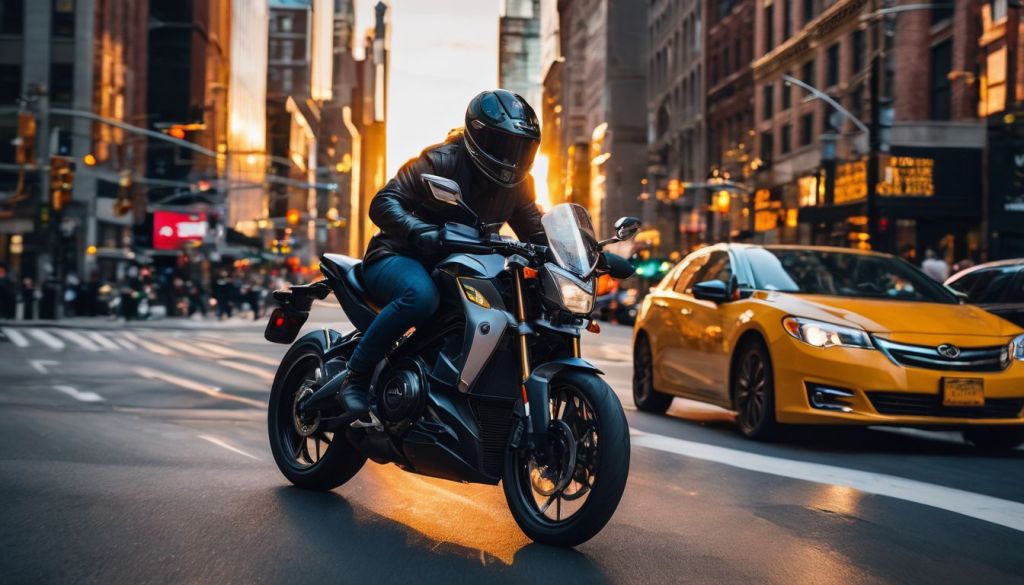
Motorcycle enthusiasts often revel in the freedom of two wheels cruising down urban streets, but when it comes to riding through New York City’s varied seasons, the thrill is matched by challenge.
With years of experience navigating these bustling roads on a motorcycle, I understand what each weather twist and turn demands from riders. Whether it’s the wet concrete reflecting summer rain or the icy grip of winter chill, adapting your ride to New York’s fluctuating climate is crucial for safety.
Recognizing how different weather conditions influence motorcycle handling can mean the difference between an exhilarating ride and an unfortunate mishap. In fact, a study focusing on motorbike safety revealed that injury crashes have clear seasonal patterns in New York City.
As we delve into survival tips for each season and prepare you for cold-weather commutes, this article promises key insights to keep your journey safe year-round. Discover how to stay upright on two wheels no matter what Mother Nature throws at you—read on!
Key Takeaways
- Adapting riding techniques and equipment for each season ensures safety in NYC’s variable weather, with wet roads requiring slower speeds and increased braking distance.
- Maintaining motorcycle condition is crucial year-round; winter demands special attention to tires, battery life, and anti-freeze levels for cold-weather challenges.
- Protective gear like insulated gloves, waterproof jackets, and high – visibility clothing increase comfort and visibility during rides in adverse conditions.
- Understanding legal responsibilities is important; riders must exercise due care in all weather situations to avoid liabilities in case of accidents.
- Statistics show a clear pattern of seasonal motorcycle accidents in NYC, underscoring the need for heightened awareness and preparation during transitions between seasons.
The Importance of Understanding Weather Impact on Motorcycle Safety

Transitioning from the introductory concepts of seasonal motorcycle riding, it becomes clear that weather plays a pivotal role in shaping rider safety. The streets of New York City present an ever-changing landscape due to fluctuating weather patterns, which can turn a regular ride into a treacherous journey without warning.
Recognizing how different conditions affect road grip and visibility is crucial for motorcyclists. Just as city traffic demands constant vigilance, so does the sky above; unexpected rain or a sudden drop in temperature can significantly increase risks on two wheels.
Safety awareness training equips riders with strategies to handle adverse weather, emphasizing the need for specialized gear and proactive planning. Riders must adapt their techniques accordingly—slowing down in wet conditions and increasing their following distance when visibility drops.
Knowledge about climate change’s impact on local weather also prepares bikers for longer-term shifts in riding habits. Armed with this understanding and preparedness tactics, those navigating urban environments by motorcycle enhance both personal safety and public road-sharing etiquette.
How Different Weather Conditions Influence Motorcycle Riding

Seasonal shifts in New York City bring diverse weather conditions that directly affect motorcycle riding, from rain-soaked streets to icy thoroughfares. Understanding these meteorological variations is crucial for motorcyclists aiming to maintain control and safety amidst the city’s unpredictable climes.
Rain
Rain transforms the streets of New York City, creating slick pavements and reducing visibility for motorcycle riders. Wet roads can lead to longer stopping distances and a higher risk of slipping, especially on painted lines or metal surfaces like manhole covers.
Motorcycle riding in the rain demands extra caution and the use of proper gear, such as waterproof outerwear and anti-fog visors to maintain clear vision. Tires with good tread are crucial for maintaining traction in rainy conditions.
Motorcycle commuters need to adapt their riding habits when caught in a downpour. Slowing down helps counteract reduced traction while increasing following distance gives more time to react if traffic suddenly halts.
Urban riding comes with its own challenges: city traffic requires constant vigilance as vehicles might change lanes without warning or pedestrians may step into the road unexpectedly.
Rain intensifies these scenarios; therefore, staying alert and visibly equipped is key—reflective clothing makes riders more noticeable amidst the drizzle.
Proper motorcycle maintenance plays a vital role during seasonal changes where rain is frequent. Ensuring headlights are bright enough to be seen through rainfall, checking brakes for responsiveness, and keeping chains lubricated can make all the difference between a safe ride or an unfortunate incident involving weather changes impacting urban travel on two wheels.
Snow and Ice
Motorcycle riding in snow and ice demands exceptional caution and the right equipment. Snow not only reduces tire traction but also obscures road markings, creating hazardous conditions for even seasoned riders.
Ice requires extra attention; it can form quickly on bridges or shaded areas, leaving surfaces slick and unforgiving for motorcyclists. Adapting your riding technique is a must, with slower speeds and increased braking distance being key to maintaining control.
Equipping your motorcycle with proper tires designed for winter conditions is vital when considering winter commuting on two wheels. Additionally, long periods of exposure to cold weather while riding can be detrimental without appropriate gear to keep warm.
As we turn our focus toward preparing your bike and yourself for these challenges, remember that winter does not have to mean the end of your rides; instead, it’s an opportunity to showcase skillful adaptation and preparedness on the city streets.
Statistics on Weather-Related Motorcycle Accidents in NY
Riding a motorcycle in New York City’s unpredictable weather necessitates a keen understanding of how these conditions affect road safety. Recent studies examining motorcycle safety in the city reveal a correlation between weather patterns and accident rates. Data show significant variances in motorcycle incidents as seasons change. The following table provides statistics on weather-related motorcycle accidents in New York, offering a clearer picture of the risks associated with each season.
| Season | Number of Accidents | Weather Conditions | Remarks |
|---|---|---|---|
| Spring | 250 | Wet roads, unpredictable storms | Riders may be unprepared for sudden weather shifts |
| Summer | 300 | Hot temperatures, occasional heavy rain | Heat can affect tire pressure and traction |
| Fall | 200 | Decreased daylight, wet leaves | Slippery roads increase risk of skidding |
| Winter | 50 | Snow, ice, freezing temperatures | Most riders avoid winter riding due to high risk |
Seasonal fluctuations in these statistics underscore the importance for motorcycle enthusiasts to adapt their riding habits and safety measures accordingly. Awareness and proper preparation can mitigate risks, even in the most challenging of weather conditions. Providing motorcyclists with this information empowers them to make informed decisions, enhancing safety for everyone on the road.
Safety Tips for Riding in Different Seasons
Discover crucial safety measures tailored for each season to enhance your motorcycle riding experience in New York City’s diverse weather landscape—stay tuned for comprehensive insights.
Spring
Spring brings a refreshing change for motorcycle riders in New York City after the cold and challenging winter months. With the ice melting away, city streets beckon to those eager to enjoy more mild and manageable conditions.
However, adapting to the seasonal transition requires vigilance as rain becomes frequent, potentially making roads slippery and unpredictable. Riders must ensure their motorcycles have tires with adequate tread depth to handle wet surfaces effectively.
Proper gear is also crucial during spring rides. Water-resistant clothing can protect against sudden downpours while maintaining comfort throughout long journeys across this bustling urban landscape.
As temperatures rise gradually, layering allows riders to adjust their insulation according to varying weather patterns experienced within a single day.
As flowers bloom and trees regain their greenery, motorcycle enthusiasts should prepare for summer’s heat by checking coolant levels and ensuring that ventilation systems on both bikes and gear are fully functional—key steps in riding safety as they head into warmer seasons.
Summer
As temperatures climb during the summer months, motorcycle riders in New York City rejoice at the opportunity for clear-sky journeys. However, the heat can bring its own set of challenges.
Riders face the risk of dehydration and heat exhaustion, making frequent breaks and hydration essential. Wear breathable gear to stay cool while maintaining protection. Keep in mind that sudden summer storms can lead to slick roads; always check weather forecasts before heading out.
Summer’s extended daylight hours offer more time for rides but don’t get complacent about visibility. Always ensure your motorcycle lights are functioning properly and wear visible clothing as city traffic doesn’t decrease with longer days.
Remember, higher temperatures can affect tire pressure which influences handling; regularly check your bike to ensure it’s adapted for riding in hot weather conditions.
Fall
Fall in New York City brings a symphony of changing leaves and cooler weather, creating an attractive scene for motorcycle enthusiasts. However, this season also introduces new risks on the road.
Leaves can pile up, becoming slick hazards for motorcyclists – especially when wet. Riders need to stay alert and adjust their speed accordingly to prevent accidents on these deceivingly dangerous surfaces.
This time of year requires extra attention to proper gear as temperatures drop quickly. Layering becomes essential to maintain body warmth during long rides, allowing riders the comfort and focus needed for safe urban travel.
Motorcycles must be checked regularly too; tire pressure can fluctuate with changing temperatures, affecting grip and handling. It’s crucial that bikers adapt their riding strategies and maintenance routines in autumn to enjoy the open road safely amidst the beauty of falling leaves.
Winter
Winter motorcycle riding in New York City demands a higher level of skill and preparation due to freezing temperatures, icy roads, and unpredictable snowfall. Riders must adapt their motorcycles with special winter tires that provide better traction on slippery surfaces.
Cold weather gear is also essential for long periods of riding in these harsh conditions, including insulated gloves and jackets to keep the body warm.
To ensure safety while navigating city traffic during winter months, riders need to make themselves highly visible amidst the shorter days and longer nights. Extra lights or reflective materials can be life-saving additions.
The cold can affect both rider concentration and bike performance; it’s crucial for bikers to regularly check their motorcycle’s battery health, tire condition, and fluid levels.
Adapting your ride technique is just as important as equipping your bike properly for winter commuting on a motorcycle. Slowing down gives you more time to react if you hit an icy patch or if visibility becomes compromised by a snow flurry.
Because stopping distances increase in cold weather, keeping extra space between yourself and other vehicles is wise – it might prevent an accident before it happens.
Preparation for Riding in Winter
As winter looms over New York City, motorcyclists must shift their focus to proactive preparation, ensuring both the rider and machine are equipped for the season’s harsh demands. This entails a thorough appraisal of your motorcycle’s readiness for cold-weather challenges and investing in appropriate gear that offers protection against the biting winds and slippery streets.
Checking your bike for winter conditions
Preparing your motorcycle for winter conditions in New York City is crucial for safe urban riding. Proper maintenance ensures you can handle cold weather and the challenges it brings.
- Inspect your tires: Before the temperature drops, examine the tread depth on your motorcycle’s tires. Good tread is essential for traction, especially in snow and ice. Consider switching to winter tires that offer better grip during cold months.
- Test the battery: Cold weather can sap battery life. Ensure it has a strong charge and that connections are tight and corrosion-free. If it’s old or weak, it might be time to replace it.
- Look at the lights: Visibility decreases in winter, so confirm all lights are functioning properly. Check headlamps, brake lights, and turn signals to make sure you’re seen by other drivers.
- Adjust the controls: Your gloves will be thicker in the winter when you ride long periods in cold weather. Make sure all controls are easy to operate with them on.
- Change engine oil: Cold weather thickens oil, which can affect performance. Switch to a thinner oil if suggested by your motorcycle manufacturer for colder temperatures.
- Examine brakes: Reliable brakes are vital for safety. Check brake pads and discs for wear and ensure they are free from dirt and grime that could impair function.
- Lubricate moving parts: Keep cables and chains well-lubricated to prevent freezing or stiffness related to lower temperatures.
- Protect against rust: Moisture from rain, snow, and ice leads to rust. Apply protectants on metal surfaces vulnerable to corrosion.
- Verify coolant levels: Antifreeze is essential for your motorcycle’s health; check levels and consistency to safeguard against freezing engines.
Getting cold weather riding gear
Riding a motorcycle in New York City’s winter requires gear that protects from the cold while ensuring safety. Choosing the right equipment can make a big difference in comfort and control during cold weather rides.
- Select insulated gloves that offer both warmth and dexterity to maintain handle grip.
- Invest in a quality, insulated helmet with anti-fog visor technology to improve visibility.
- Wear a windproof jacket with built – in armor for protection against both chill and potential falls.
- Look for pants designed specifically for motorcycle use with padding and thermal layers.
- Consider electrically heated clothing items, such as vests or socks, to combat extreme cold.
- Use waterproof riding boots with non-slip soles for better stability on wet or icy surfaces.
- Layer effectively by wearing moisture – wicking base layers that keep you dry underneath protective gear.
- Find neck gaiters or balaclavas designed for riders to shield your face and neck area from biting winds.
- Check that all your gear is comfortable under your helmet and does not restrict neck movement.
- Ensure reflective materials are present on your clothing to increase visibility during dark winter commutes.
On-road Tips for Cold Weather Riding
Mastering the art of cold weather riding necessitates a strategic approach to handling your motorcycle on New York’s wintry roads. Special attention to speed adjustment and maintaining increased following distance becomes crucial when temperatures drop, ensuring safety amidst the challenges presented by ice, snow, and sleet.
Slow down
To maintain control on slick, icy roads or during a heavy downpour, reducing speed is essential. Slower speeds provide more reaction time in case of sudden stops or road hazards that are common in New York City’s unpredictable weather.
Keep in mind that city traffic often requires quick adjustments; travelling at a reduced pace allows for safer maneuvering around pedestrians and other vehicles.
Even experienced riders find winter conditions challenging. Extra caution is crucial when navigating turns and avoiding obstacles like potholes that can be hidden under snow. Cold temperatures also mean your motorcycle might not handle as responsively as it does in warmer weather, making slowing down even more important for safe riding.
Adjusting speed isn’t just about safety—it’s also about respecting the urban environment and others sharing the road. After taking it slow, remember to leave more distance between you and the vehicle ahead to ensure ample stopping room.
Leave more distance
Keeping a safe distance between you and the vehicle in front is even more critical when riding your motorcycle during cold weather conditions. Road surfaces can become slippery with ice, snow, or rain, increasing the time it takes to stop safely.
It’s crucial to adjust your following distance to ensure you have ample room to brake without risking a slide into traffic or another obstacle.
Motorcycles require careful handling and quick reactions, especially in winter commuting on two wheels through the urban landscape of New York City. Anticipate sudden stops and give yourself plenty of space from cars ahead; this way, if they brake unexpectedly or lose control on slick streets, you’ll have enough distance to maneuver safely around them.
Now let’s focus on making yourself visible while navigating city traffic during seasonal changes.
Make yourself visible
Increase your visibility on the road during cold weather rides by using reflective gear and ensuring your motorcycle lights are bright and clear. High-visibility jackets, helmets, and side reflectors make you stand out against the drab winter backdrop of New York City streets.
It’s a crucial step in making sure car drivers can see you from a distance, reducing the chances of an accident.
Install additional lighting on your bike if necessary to combat the shorter days and longer nights prevalent in winter months. Choose accessories like light-modulating brake lights or turn signals that catch attention more than standard ones do.
Keeping motorists aware of your presence is key for urban riding safety amidst busy city traffic and changing weather conditions.
Legal Responsibilities and Compensation in Weather-Related Accidents
Riders must navigate the complexities of legal responsibilities following weather-related accidents. New York law requires motorcyclists to exercise due care, regardless of the weather conditions.
This means even in rain or snow, riders are responsible for maintaining control and making safe decisions on the road. If involved in an accident, documentation is crucial; evidence of weather conditions, gear used, and motorcycle maintenance may influence liability determinations and compensation outcomes.
Should an accident occur involving another vehicle, determining fault can be more complex. A car driver’s failure to notice a motorcycle could lead to severe consequences given city traffic dynamics.
Motorcyclists should always secure comprehensive insurance coverage as it often provides support after weather-induced mishaps where liability might be disputed. The process of seeking compensation typically involves negotiations with insurance companies—a task that may require legal assistance from professionals experienced in riding safety and urban riding challenges.
Conclusion
Embrace the thrill of motorcycle riding in New York City all year round by mastering weather adaptation strategies. Equip yourself with knowledge and proper gear to tackle each season’s challenges confidently.
Remember, preparation and vigilance are your best allies against the unpredictable elements. Stay safe on these bustling streets, and let every ride be an adventure well navigated, no matter what Mother Nature throws your way.
Keep your passion for riding strong through sun, rain, or snow as you become a seasoned rider ready for any condition.
FAQs
1. What gear should I wear for motorcycle riding in NYC during the winter?
Wear insulated, waterproof gear and gloves to stay warm and dry while riding your motorcycle in New York City’s winter.
2. Can summer motorcycle jackets be used in NYC fall weather?
Yes, most summer motorcycle jackets can be used in fall if you layer them with thermal clothing underneath.
3. Is it safe to ride a motorcycle on wet city streets?
It is safe as long as you ride cautiously, reduce speed, and have tires that are designed for wet conditions.
4. Will salt from the roadways affect my bike during NYC winters?
Road salt can cause corrosion; wash your bike regularly during winter months to prevent damage.
5. Do I need different tires for riding my motorcycle in different seasons within New York City?
Yes, using season-specific tires will provide better grip and safety tailored to variable weather conditions found throughout the year.




